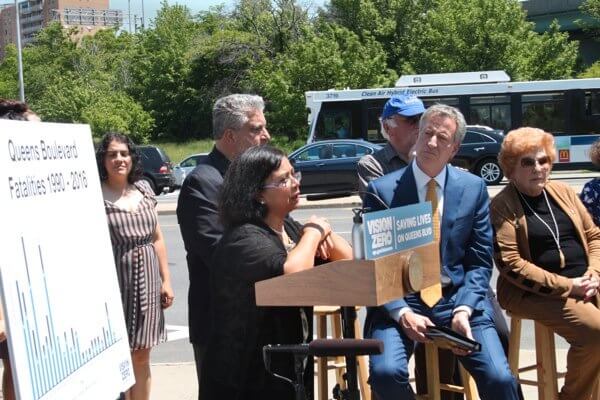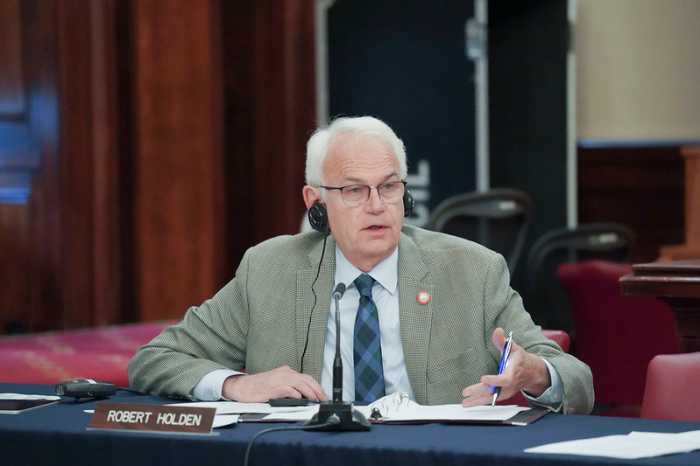By Bill Parry
The city will move forward with the third phase of the Queens Boulevard redesign project next month, bringing major safety improvements to the roadway — including new protected bike lanes, repaved crosswalks and expanded medians — through Rego Park and Forest Hills, Mayor Bill de Blasio announced Wednesday.
Community Board 6 gave the controversial plan the green light May 10 after a 34-3 vote in favor of the improvements along a 1.3-mile stretch from Eliot Avenue in Rego Park to Yellowstone Boulevard in Forest Hills.
“Queens Boulevard offers the best and most dramatic proof that our efforts at Vision Zero are working,” de Blasio said at an Elmhurst news conference. “What was once a ‘Boulevard of Death’ is no longer — as pedestrians, cyclists and motorists all have become accustomed to enjoying a more vital, welcoming and safe street. As changes come this year to Forest Hills and Rego Park, we thank Council member Karen Koslowitz (D-Forest Hills) and Community Board 6 for its recognition that a new Queens Boulevard is a win-win for all of the community’s businesses, children and seniors.”
Koslowitz called Queens Boulevard her baby, after living near it for 54 years in either Rego Park or Forest Hills, always worried for her children’s safety.
“This latest DOT plan, with its pedestrian and bike safety improvements, will continue the transformation of this major thoroughfare from the ‘Boulevard of Death to the ‘Boulevard of Life,’” she said. “So many lives were lost. So many people that I knew were killed on that boulevard.”
Queens Boulevard, which had 22 traffic fatalities as recently as 1997, has not had a single traffic fatality in 2 1/2 years, the same time DOT began the street’s conversion into a Vision Zero Priority Corridor. In addition to the absence of fatalities, DOT statistics show that since work began crashes in the first phase corridor in Sunnyside and Woodside have declined by 14 percent, with pedestrian injuries down 49 percent and cyclist injuries down 42 percent, while cycling increased by 120 percent.
“The transformation of Queens Boulevard is among the greatest achievements of the Vision Zero era,” DOT Commissioner Polly Trottenberg said. ““In just a few years, what was once a forbidding highway-like street bisecting communities has started to become a grand and welcoming boulevard worthy of Queens.”
All of DOT’s changes to Queens Boulevard will cost nearly $4 million. Starting next year, major capital work — for which the de Blasio administration has committed $255 million — to transform the boulevard, making all three phases permanent, including by widening medians and adding new amenities like trees, landscaping and benches.
It is all a dream come true for Lizi Rahman, a Flushing resident whose son Asif was riding his bike to work in February 2008, when he swerved to avoid a double-parked car and was struck and killed by a truck. Lizi became an activist saying her 22-year-old son would be alive today if the boulevard had featured protected bike lanes then.
“It’s been a long fight that brings back memories both sad and positive, but we did it and I’m very excited,” Rahman said before introducing the mayor. “I almost gave up several years ago, but we got a big boost when Mayor de Blasio came to office. All the years of negativity and pessimism were replaced by action.”
Reach reporter Bill Parry by e-mail at bparr



































